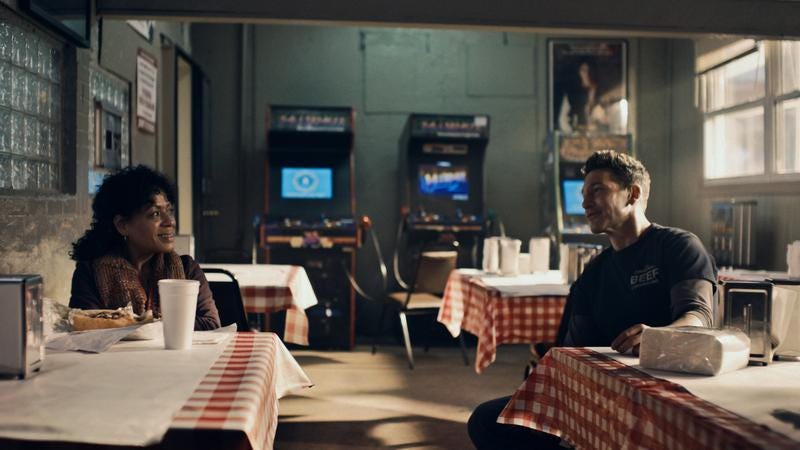Discussed: The Bear, Ted Lasso, Stranger Things, Transparent, Ramy, BoJack Horseman, minimalism, emotion
What is it about The Bear that feels so real?
It’s a question I’ve been asking myself since I first started watching the series. Like many people, I found the first few episodes of Season 1 to be viscerally overwhelming, from the sound of clanging pots and pans to the nonstop explosion of yelling. Over time, the show has explored a wider array of emotional tones, with many of the quieter episodes pulling just as big an emotional punch as ones that focus on family fights. One of the quirks of the popularity of The Bear is that it goes against the supposed dominant narrative of comfort viewing. You don’t tune in to The Bear to relax. You watch to be emotionally eviscerated.
More than twenty years after the dawn of prestige TV, we’re no longer surprised when a show is challenging and complex, but we also tend to assume that emotional depth is achieved through longer episode formats. In his essay, “A Shot in the Arm” my Together, Alone co-creator, Gabe Bullard made the insightful argument that The Bear’s format blends elements of prestige TV with the structure of the traditional sitcom. As I’ve continued to watch the show and think about this idea, I’ve wondered about the way this format doesn’t just reinvent the sitcom but also allows for unique emotional depth.
This is particularly true in the type of storytelling we see in Season 3 of The Bear, which embraces a collage-like style that zig zags across timelines and invites viewers to go deeper into the world of beloved characters by focusing on snapshot moments of acute emotional power. On paper, this may sound too avant-garde to be engaging. But the actual experience watching is just the opposite. Nothing on TV today feels quite as committed to authentic emotional expression as The Bear does.
Season 3’s “Napkins,” which focuses on Tina’s backstory, is a perfect example of this immersive realism. Over the course of 30 minutes, we’re invited into Tina’s world through the experience of her daily routine. We watch her wake up early, make food, go to work. After losing her job, we watch her embark on a new routine of job hunting with the same steady determination. She prints out resumes and takes the bus to deliver them in person. At every office and storefront, a much younger employee turns her away.
Like all episodes of The Bear, emotion builds methodically and is most often illustrated through small details that aren’t so small at all. We see photographs of Tina’s son at her office and home and we watch the loving relationship between Tina and her husband, a connection that is anchored in both practical conversations about money, as well as genuine tenderness. By the time Tina ends up at The Original Beef of Chicagoland at the episode’s 16-minute mark, we don’t just share in Tina’s exhaustion at her failed job hunt; we fundamentally understand who Tina is.
Whenever I sit down to watch The Bear, I find myself preparing for emotional impact. I was on the edge of my seat throughout, “Napkins,” so much so that when I watched Tina finally sit down to rest and eat her free sandwich after another day of failed job searching, I found myself sobbing along with her. Much of the emotional experience of the episode comes from the extraordinary talent of Liza Colón-Zayas who conveys strength and softness in Tina’s every glance. The power of the episode also stems from Ayo Edebiri’s directorial vision and her commitment to exploring real characters and their raw and unfiltered emotion.
The best episodes of The Bear unfold so naturally that they feel entirely unscripted. You forget that you are watching TV at all.
Many series end up expanding into a longer episode format once they gain enough acclaim to secure a bigger budget. Ted Lasso shifted to hour-long episodes in its final season and the upcoming season of Stranger Things will feature “movie length” episodes. In some cases, the longer format does allow more space for great storytelling, but the 30-minute format itself can also be a conduit to greater emotional depth. Many of my favorite shows of the past decade embrace a similar commitment to the short form as The Bear does. Transparent deftly explores gender, sexuality, and Jewish-American identity. Ramy offers a moving, deeply felt, and hilarious look at a young first-generation Egyptian-American’s experience searching for love and spiritual growth. And, of course, BoJack Horseman, which I’ve long called the most empathetic show on television, is a searing look at generational trauma that packs just as big an emotional punch as longer TV dramas.
These 30-minute masterpieces are deeply invested in exploring the lives of complex and often troubled characters, many of whom say cruel things and behave in ways that are selfish, self-serving, or just plain immoral. But the 30-minute format itself prevents the kind of wallowing that we sometimes see in shows that have a longer episode length, when a show gets weighed down by too many new characters or extraneous plot points. The Bear offers a vision of TV-making that is perhaps most akin to Carmy’s fine dining philosophy: everything pared back to its most essential parts.









